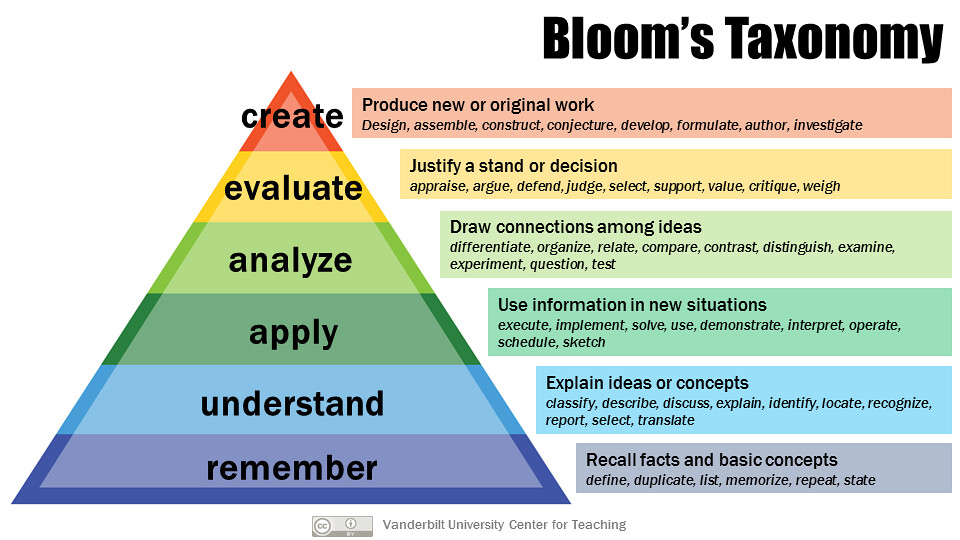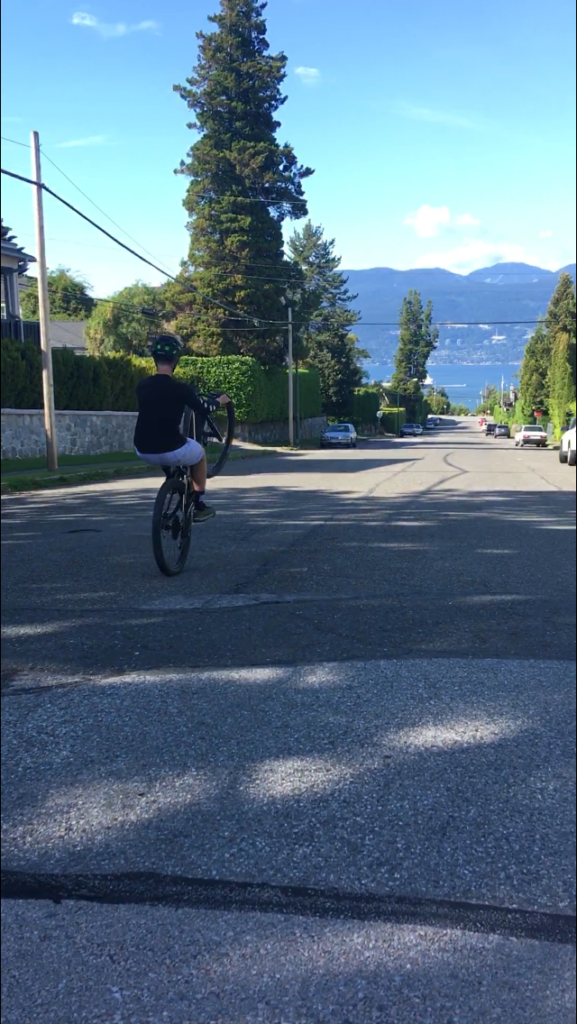Backward Design and Understanding by Design
The UbD model is a framework that states what students should understand and be able to do by the end of a unit or module, then design assessments and learning activities to attain those outcomes. “Who do I want to be” is a question I often ask myself before starting something new. Is this a highly transferrable skill? Will this make me a better person? Does the benefit outweigh the risk and consequences? This shift from being a “forward design” where people plan content and then connect them to learning, is a more intentional process that begins with clearly defined outcomes.
| Stages of backwards design | Definition |
| Identifying desired results | Establish the learning goals and outcomes |
| Determine acceptable evidence | Assessing if people have achieved these learning goals |
| Plan learning experiences and instruction | Design activities to meet outcomes. |
Instead of beginning with content and activities, educators identify the knowledge and skills learners should be able to demonstrate by the end of the experience, determine how learning will be assessed, and design activities that support the outcome. By ensuring that activities and assessments are connected to long-term objectives rather than discrete tasks, this structured method helps maintain instruction’s focus and significance.
In my case, this term I have a couple classes with portfolios that are due at the end of the month. The information, tasks, due dates, exams, and outlines have been posted since the first day of class. I have never had this before in university and have struggled with this in the past. In these classes, I have found success AFTER fully understanding what is required of me, as by working backwards in my thought process and breaking down tasks to make the work load more manageable. I am able to stay focused, organized, reduce my stress levels, and make steady progress towards the final goal.
Design thinking
Education has become one size DOES NOT fit all. Design thinking moves away from delivering content to understanding what learners want and need, designing meaningful experiences that encompass individualized experiences, as well as a solution for the general population.
This video by Sprouts outlines what design thinking is all about.
- Empathize: Conduct interviews to find out what people care about.
- Define the problem: Understand the needs of the people.
- Ideate: Focusing on the problem statement and come up with ideas that solve the problem.
- Prototype: Reflect on what you’ve learned from the conversations about different ideas, connect the dots, and create.
- Test: Use the idea with the people themselves, receive feedback, refine, then finalize.
Last winter/spring, I had the opportunity to create a carnival game for my out of school care kids. All of the leaders had to create their own game for their own station. I first started with asking all the kids what the liked about their previous experiences with carnival games, and what could make it better/more fun (empathize). The conclusion was that they wanted more water games, not just a dunk tank, but something that involved many people competing for something. I came up with the idea (defined the problem) of a race that they had to fill up water balloons as quickly as possible without it popping, and the winner was the person that had the most water in their balloon. I started thinking about the cost, the resources, time it would take to make, was it easy to understand, and could everyone participate (ideate)? I then started making prototypes of the race and how it would be set up (prototype).
The material I used was:
- Low table
- Hose spigot (multi-way splitter)
- Hose connectors
- Garden hose (cut into smaller pieces)
- Water balloons
- Extra balloons
I cut up the hose I bought into smaller pieces, then attached the spigot to the main hose, and the connector onto the end of each of each hose I had cut up. The kids had to run up to the table, fit the ends of their balloon over the end of the hose, and whoever filled up their balloon the most without popping won.
It took a-lot of effort and only cost around $55. This process changed my views on problem solving and coming up with creative solutions. By refining and trying different ways to make the game work, using zap straps and crazy glue, as well as different brands of water balloons, I would change how I went about the game in my time management. It took along time to get everything sorted and put together, whereas in the future, designing a prototype online or in a quick sketch would have been a more resourceful solution in managing my time. In the end it was all about the kids reactions and they loved it, showing myself that it was worth my effort and created a memorable experience.
Learning Outcomes and Bloom’s/Solo Taxonomies
Out of the two taxonomies, I find Blooms to be more helpful when describing levels of learning as it shows a straightforward hierarchy that shows the cognitive process that makes the outcomes easier to design and align with assessments.

Using Bloom’s Taxonomy verbs, it’s easier to see whether an outcome involves remembering, applying, or the higher levels of thinking. A educator might look at someone’s work, where they are at, and figure out where along the way they might need more time and practice. The pyramid is a great visual tool as well, as someone who is learning needs a solid foundation and understanding of the work and how they learn themselves, as everyone is different. The skills and abilities continue to evolve as they dive in more complex ways of thinking moving onto each step of the pyramid, which is why Bloom’s Taxonomy’s is more helpful in describing the levels of learning.
Using Bloom’s verbs, it becomes clear whether an outcome is asking for recall, application, or higher-order thinking
For example, a weak outcome might be:
“Students will understand the causes of World War ll.”
A strong outcome looks like:
“Students will be able to explain the main causes of World War ll, and evaluate how immediate and underlying conflicts triggered the war.”
Better Learning Design
During my first two years of university, I didn’t know to take notes, to study, heck even know what program I was in or wanted for my career. I took down every single note in class, participated in discussions, went to most of my classes, and every lab I was sure I had a deeper understanding and knowledge of the content. When I didn’t achieve the grades I desired, it took way too long for me to realize things needed to change. I used to read and type out every single detail I needed to remember, regurgitating everything back to myself. The surface learning was there, but no deep learning took place.
According to the Wellbeing Thesis, “students who approach learning at a deeper level generally experience greater overall wellbeing and achieve stronger academic outcomes, while those who rely on surface learning are often more anxious and perform below their potential (Hughes & Kirkman, 2019).” That statement emphasizes how students who experience learning at a deeper understanding have greater success than those that don’t. This led me to practice a deeper level of learning by the time third year rolled around by practicing a more hands on method, self-instructing definitions and tables of information, writing on flashcards and quizzing myself. Those are all ways I learned how to become a better student.
My learning process design was the biggest part in my studies. Taking my initial design, figuring out what needed to change, then adapting to a redesigned approach where I made deeper more meaningful connections and strengthen my understanding of the material.

In the last blog, I exclaimed that I am very passionate about mountain biking. Since I picked up mountain biking when I was nine years old, I have always wanted to learn how to wheelie.
This learning by doing method has taken me nearly over a decade to learn how to wheelie a mountain bike. Over and over again, wherever I went I practiced. Where do I put my weight, are my hips over the centre of the bike, are my arms straight, is my chest high, keep one finger on the back brake, are all the components of a wheelie that took a long time to learn how to do.
My environment design was a huge part of my learning for how to wheelie. Structuring my progression, my environment and tools I was using, shaped how safely and effectively I moved from basic attempts to performing the perfect wheelie.
Inquiry and Project – Based Learning
Both of these approaches emphasize learning by doing, reflecting, and applying knowledge. Project-based learning is how I approach my tasks. In the context of becoming an occupational therapist, I will learn through case studies and hands-on projects where I will design interventions for clients with specific needs. Rather then memorizing treatment techniques, asking open-ended questions such as, “How might this client’s environment impact the quality and quantity of their work?” or “What changes could be made to make tying shoes easier?” This is an example of project based learning, where exploration and problem solving can help create a deeper understanding of what connects my learning to authentic, real-world challenges.
A clear benefit of exploration and problem solving on the spot is that it pushes learners to think more critically and apply knowledge in meaningful ways. On the other hand, a challenge around open-ended questions is that can feel overwhelming without enough structured support, and it can be hard to evaluate objectively. Having a balance of both freedom and structure is the solution to making inquiry and project-based learning successful.
References
Hughes, G., & Kirkman, A. (2019). Deep and surface learning. The Wellbeing Thesis. https://thewellbeingthesis.org.uk/why-you-are-engaging-in-pgr-study/deep-and-surface-learning/
Western Michigan University. (n.d.). Backward design. Teaching & Learning. https://wmich.edu/x/teaching-learning/teaching-resources/backward-design#:~:text=Brief%20Overview,by%20Design%20Workshop%20Series%20recording.
Lucas, J. (2017, September 12). STEM Teaching Essentials – Backward Design [Video]. YouTube. https://www.youtube.com/watch?v=_r0VX-aU_T8
TCEA Blog. (2021, September 9). Why it may be time to dump Bloom’s taxonomy. https://blog.tcea.org/why-it-may-be-time-to-dump-blooms-taxonomy/

